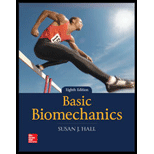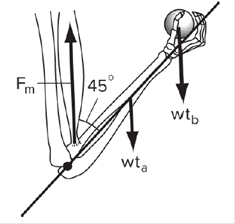
Concept explainers
A 35-N hand and forearm are held at a 45° angle to the vertically oriented humerus. The CG of the forearm and hand is located at a distance of 15 cm from the joint center at the elbow, and the elbow flexor muscles attach at an average distance of 3 cm from the joint center. (Assume that the muscles attach at an angle of 45° to the bones.)
a. How much force must be exerted by the forearm flexors to maintain this position?
b. How much force must the forearm flexors exert if a 50-N weight is held in the hand at a distance along the arm of 25 cm? (Answers: a. 175 N; b. 591.7 N)

a)
To determine: The force exerted by the forearm.
Answer to Problem 3AP
The force exerted by the forearm is
Explanation of Solution
Calculation:
Consider torque acts on the counter clockwise direction for forearm of the hand will be taken as positive and the torque acts on the clockwise direction for joint center of the elbow will be taken as negative.
Express the magnitude of the net torque acts on the joints.
Here,
Rewrite the equation (I) for the net forces acts on the joints of the hand.
Here,
Substitute
Therefore, the force exerted by the forearm is
b)
To determine: The force on the forearm flexors exerts on the weight hold in the hand.
Answer to Problem 3AP
The force on the forearm flexors exerts on the weight hold in the hand is
Explanation of Solution
Calculation:
Rewrite the equation (I) for the net forces acts on the weight holds in the hand.
Here,
Substitute
Solve the relation for
Therefore, the force on the forearm flexors exerts on the weight hold in the hand is
Want to see more full solutions like this?
Chapter 13 Solutions
BASIC BIOMECHANICS
- Due to fiber alignment, the quadriceps muscle group is better at producing increased force, not velocity. True Falsearrow_forwardWhat are two factors which allow the gastrocnemius and soleus muscles to generate greater plantar flexion torque than all the other muscles capable of plantarflexion?arrow_forwardLocate and list two different pairs of muscles that act as on the body as agonist/antagonist. (That is, in each pair, one muscle will produce a movement, such as flexion, that the other muscle will undo, and produce extension; abduction/adduction, etc. are other ways that muscle produce opposite actions on the same part of the body).Name two muscles that act as “fixators.” (What are fixators?) What joint or joints are they helping to stabilize?Why is the biceps brachii called a “bicep,” while the triceps brachii is called a “triceps?”What is the difference between a muscle with “longus” as part of its name and a muscle with “brevis” as a part of its name?arrow_forward
- When you flex your biceps brachii while doing “biceps curls,” what is the type of movement?arrow_forwardExplain why the adductor longus muscle is a more effective hip adductor than the pectineus?arrow_forwardDescribe the movement in the sagittal plane for knee and hip in relation to the jump task in the plot.arrow_forward
- Describe the bony articulations and movementsspecific to shoulder joint rotation during the accel-eration phase of the throwing motion and how anathlete can work toward increasing the velocity ofthe throw. What factors affect the velocity of thethrow?arrow_forwardThe Triceps is activated with the goal of producing only elbow extension. 1. Which of the following muscle functional classification would be needed Synergist/Neutralizer or Fixator/Stabilizer or both? 2. What are all of the possible muscles that could fulfill this role?arrow_forward
 Human Physiology: From Cells to Systems (MindTap ...BiologyISBN:9781285866932Author:Lauralee SherwoodPublisher:Cengage LearningLifetime Physical Fitness & WellnessHealth & NutritionISBN:9781337677509Author:HOEGERPublisher:Cengage
Human Physiology: From Cells to Systems (MindTap ...BiologyISBN:9781285866932Author:Lauralee SherwoodPublisher:Cengage LearningLifetime Physical Fitness & WellnessHealth & NutritionISBN:9781337677509Author:HOEGERPublisher:Cengage Fundamentals of Sectional Anatomy: An Imaging App...BiologyISBN:9781133960867Author:Denise L. LazoPublisher:Cengage Learning
Fundamentals of Sectional Anatomy: An Imaging App...BiologyISBN:9781133960867Author:Denise L. LazoPublisher:Cengage Learning


